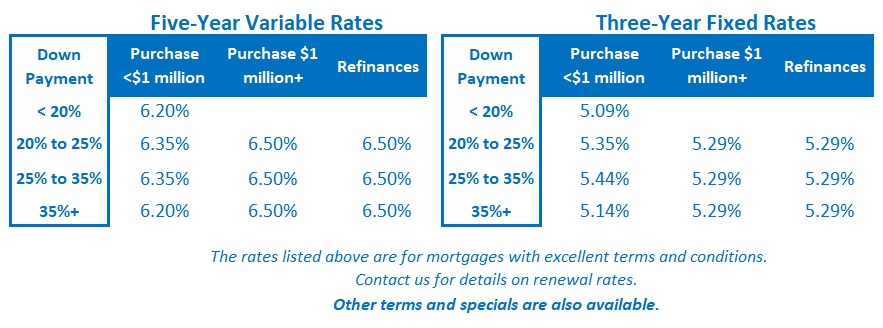Canadian Mortgage-Related News Update – Separating Wheat from Chaff
April 1, 2024Five Mortgage Highlights from the Bank of Canada’s Latest Update
April 15, 2024
The Bank of Canada (BoC) isn’t expected to lower its policy rate when it meets this Wednesday, but the bond futures market is estimating an 80% chance of a cut at the Bank’s next meeting on June 5 (and is pricing in two more 0.25% decreases over the remainder of 2024).
Rate cuts will be welcome news to variable-rate mortgage borrowers, many of whom have seen their initial rates increase by as much as 4.75% from their pandemic lows.
If rate decreases are in the offing, the BoC will normally intimate that ahead of time because it knows that financial markets don’t like surprises. It may not do that this time.
The key indicators the Bank is focused on haven’t yet made a convincing case that inflation is on a clear path back to its 2% target. Hinting at rate cuts could undermine some of the progress made thus far. For example, there is a lot of pent-up demand in our largest real-estate markets. The prospect of imminent rate cuts might unleash a wave of activity that would increase prices and fuel spending in a wide range of real-estate-related areas.
Here is an updated snapshot of the four key areas the Bank is keying on when assessing our current inflation outlook:
- The Balance Between Supply and Demand in the Economy
In its January 2024 Monetary Policy Report (MPR), the Bank assessed that our economy had moved from a state of excess demand to a state of excess supply. The economic data we have received since then have mostly supported that view. For example, while our most recent GDP came in higher than expected, our latest employment data confirmed that the supply of labour continues to increase more rapidly than our economy’s demand for it.
The key risk here is tied to government spending. The provincial budgets that have just been rolled out include spending increases that will undermine the BoC’s attempts to cool the economy. Early indications are that our federal budget will do the same. As BoC Governor Tiff Macklem pointed out not too long ago, fiscal and monetary policies are rowing in different directions.
- Inflation Expectations
The release of the BoC’s latest Consumer Expectations and Business Outlook surveys confirmed that inflation expectations are continuing to moderate, but only slowly.
For example, Canadian consumers perceived that inflation decreased over the last quarter, but they expect it to increase again over the near term. Most concerningly at the margin, they now expect that higher government spending, elevated home prices and increasing rent costs will lead to more inflation five years from now.
For their part, business expectations of future inflation continued to decline, but that view was underpinned by weak demand, which is curtailing investments in capacity expansion.
- Wage Growth
Our latest employment data, for March, showed that our economy shed 2,200 jobs last month. But average wages still increased by 5.1% on year-over-year basis, up from 5.0% in February.
Our unemployment increased from 5.8% in February to 6.1% in March. More labour capacity should eventually reduce wage pressures, but right now the combination of increasing wage growth and decreasing productivity is pushing inflation in the wrong direction.
The latest surveys show that Canadian consumers feel increasingly positive about labour-market conditions, and they anticipate stronger-than-average wage growth ahead. Businesses expect wage growth to slow as wages catch up with cost-of-living increases, but planned wage adjustments are still high, at 4.1% on average, and are well above the BoC’s 2% inflation target.
- Corporate Pricing Behaviour
According to the latest Business Outlook Survey, fewer firms now plan to initiate “unusually large or frequent price increases” over the next year. It also confirmed that “pricing behaviour is continuing to normalize”, although “slow moderation in wage growth and the gradual pass-through of high costs are keeping output price growth elevated”.
In summary, the four key factors the BoC is most focused on show some progress toward reduced inflation pressure. But that progress remains both gradual and tepid enough to be vulnerable to reversal by some combination of profligate government spending, a resurgence in real-estate activity, and/or a spike in prices stemming from geopolitical unrest.
Conditions in the US also aren’t helping much right now.
The US economy is running much hotter than ours. If the timing and magnitude of rate cuts by the BoC and the Fed differ too much, the Loonie will weaken against the Greenback, inflating the price of everything we buy from US markets. (On Friday, as referenced above, weaker-than-expected Canadian employment data were met with stronger-than-expected US employment data. The Loonie immediately dropped by half a cent in response, and that could be a sign of things to come if our economic trajectories continue to diverge.)
Mortgage Selection Advice
If you’re a conservative borrower concerned that stickier-than-expected inflation will continue to keep rates elevated, I think a three-year term still represents your best choice among today’s available fixed-rate options. The premiums required for one- and two-year fixed rates remain substantial. While five-year fixed-rate terms come with today’s lowest rates, I worry that five years is too long to be locking in when rates are still near their highest levels in more than three decades.
On the other hand, if you’re willing to pay an upfront rate premium and can tolerate a higher-risk option, I think variable rates are still an option well worth considering. While we can never be certain how things will play out, and there is now a somewhat increased risk that the BoC’s first rate cut may take longer to materialize, I still think the Bank will cut its policy rate substantially during the next phase of the rate cycle.
In fact, I believe that the longer the first cut takes, the more the BoC will eventually have to cut (because it will have over-tightened and will then be required to correct course more forcefully). The Bottom Line: Government of Canada bond yields are being pulled higher by their US Treasury equivalents, and fixed mortgage rates are starting to move higher in response.
The Bottom Line: Government of Canada bond yields are being pulled higher by their US Treasury equivalents, and fixed mortgage rates are starting to move higher in response.
As I wrote in this recent post, the US bond-yield tailwind that carried our fixed mortgage rates lower earlier this year has now reversed into a headwind that may soon pull them higher – at a time when our domestic data should be pulling them lower.
My bet is that the BoC will surprise markets by maintaining hawkish language, which emphasizes the need to maintain its policy rate until more progress is made. There is little doubt that mortgage rates will eventually start to fall, but I think the market is still too optimistic about when that process will begin.








2 Comments
Dave Actually the probabilities are 92% for -0.25% in June, 94% for another -0.25% in Sep, and 94% for another -0.5% in Dec. So 3 rate cuts for 2024. https://www.m-x.ca/…/canadian-interest-rate-expectations
And the interest rates on Canadian bonds did not move higher. They are still caught in the same range where they’ve been since mid-Feb
Thanks for your comment Mihai. It looks like my estimate of the BoC’s rate cut probabilities is already out of date. (That’s why I’m careful to use “about” and “approximately” when referencing those odds in my posts.)